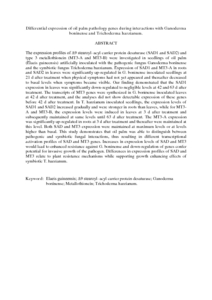Citation
Alizadeh, Fahimeh and Abdullah, Siti Nor Akmar and Khodavandi, Alireza and Abdullah, Faridah and Yusuf, Umi Kalsom and Chong, Pei Pei
(2011)
Differential expression of oil palm pathology genes during interactions with Ganoderma boninense and Trichoderma harzianum.
Journal of Plant Physiology, 168 (10).
pp. 1106-1113.
ISSN 0176-1617; ESSN: 1618-1328
Abstract
The expression profiles of Δ9 stearoyl–acyl carrier protein desaturase (SAD1 and SAD2) and type 3 metallothionein (MT3-A and MT3-B) were investigated in seedlings of oil palm (Elaeis guineensis) artificially inoculated with the pathogenic fungus Ganoderma boninense and the symbiotic fungus Trichoderma harzianum. Expression of SAD1 and MT3-A in roots and SAD2 in leaves were significantly up-regulated in G. boninense inoculated seedlings at 21 d after treatment when physical symptoms had not yet appeared and thereafter decreased to basal levels when symptoms became visible. Our finding demonstrated that the SAD1 expression in leaves was significantly down-regulated to negligible levels at 42 and 63 d after treatment. The transcripts of MT3 genes were synthesized in G. boninense inoculated leaves at 42 d after treatment, and the analyses did not show detectable expression of these genes before 42 d after treatment. In T. harzianum inoculated seedlings, the expression levels of SAD1 and SAD2 increased gradually and were stronger in roots than leaves, while for MT3-A and MT3-B, the expression levels were induced in leaves at 3 d after treatment and subsequently maintained at same levels until 63 d after treatment. The MT3-A expression was significantly up-regulated in roots at 3 d after treatment and thereafter were maintained at this level. Both SAD and MT3 expression were maintained at maximum levels or at levels higher than basal. This study demonstrates that oil palm was able to distinguish between pathogenic and symbiotic fungal interactions, thus resulting in different transcriptional activation profiles of SAD and MT3 genes. Increases in expression levels of SAD and MT3 would lead to enhanced resistance against G. boninense and down-regulation of genes confer potential for invasive growth of the pathogen. Differences in expression profiles of SAD and MT3 relate to plant resistance mechanisms while supporting growth enhancing effects of symbiotic T. harzianum.
Download File
![[img]](http://psasir.upm.edu.my/24581/1.hassmallThumbnailVersion/Differential%20expression%20of%20oil%20palm%20pathology%20genes%20during%20interactions%20with%20Ganoderma%20boninense%20and%20Trichoderma%20harzianum.pdf)  Preview |
|
PDF (Abstract)
Differential expression of oil palm pathology genes during interactions with Ganoderma boninense and Trichoderma harzianum.pdf
Download (183kB)
| Preview
|
|
Additional Metadata
Actions (login required)
 |
View Item |

